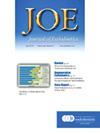评价牙髓显微手术的结果和预后因素:一项回顾性队列研究。
IF 3.6
2区 医学
Q1 DENTISTRY, ORAL SURGERY & MEDICINE
引用次数: 0
摘要
结果研究对循证牙髓学至关重要。本研究评估了根管显微手术(EMS)的根尖周围放射学愈合率和再干预存活率,以及与这些结果相关的预后因素。方法:回顾1999年至2021年间多伦多大学EMS治疗的牙齿记录。每颗牙齿都被跟踪,直到最后的随访(至少一年)或发生意外事件。分别采用logistic回归和Cox回归分析根尖周愈合、生存及其预后因素。计算中位数(IQR)、优势比(OR)、风险比(HR)和95%置信区间(CI)。结果:共有128颗牙齿符合根尖周放射学分析标准,186颗牙齿纳入生存分析。根尖周放射治疗的中位随访时间为41.5个月(IQR: 27.8-72.9)。在最近的随访中,根尖周围的整体x线片愈合率为82.8%,与牙周不受累(OR: 2.8, 95% CI: 1.1-7.7, P = 0.045)和根端充填深度> mm (OR: 3.5, 95% CI: 1.2-9.6, P = 0.014)显著相关。中位生存随访时间为37.5个月(IQR: 22.3-61.6);86.6%的牙存活,无需再干预,1.6%需要治疗,11.8%拔除。年龄≤45岁(HR: 3.0, P= 0.036)、根端充填≤2mm (HR: 4.3, P= 0.004)均增加干预风险。结论:EMS术后根尖周放射学治愈率和生存率均较高。预后因素被确定,需要在未来的研究中确认。本文章由计算机程序翻译,如有差异,请以英文原文为准。
Evaluating Outcomes and Prognostic Factors in Endodontic Microsurgery: A Retrospective Cohort Study
Introduction
Outcome studies are essential for evidence-based endodontics. This study evaluates rates of radiographic periapical healing and survival to reintervention in endodontic microsurgery (EMS), along with the prognostic factors associated with these outcomes.
Methods
Dental records were reviewed to identify teeth treated with EMS at the University of Toronto between 1999 and 2021. Each tooth was tracked until the final follow-up (minimum of 1 year) or an untoward event. Radiographic periapical healing, survival, and their prognostic factors were analyzed using logistic and Cox regression, respectively. Median (interquartile range [IQR]), odds ratios (ORs), hazard ratios (HRs), and 95% confidence intervals (CIs) were calculated (P < .05).
Results
A total of 128 teeth met the criteria for radiographic periapical healing analysis, and 186 teeth were included in the survival analysis. The median follow-up time for radiographic periapical healing was 41.5 months (IQR: 27.8–72.9). At the latest follow-up, the overall radiographic periapical healing rate was 82.8%, and it was significantly associated with the absence of periodontal involvement (OR: 2.8, 95% CI: 1.1–7.7, P = .045) and root-end filling depth >2 mm (OR: 3.5, 95% CI: 1.2–9.6, P = .014). Median survival follow-up time was 37.5 months (IQR: 22.3–61.6); 86.6% of teeth survived without reintervention, 1.6% required treatment, and 11.8% were extracted. Age ≤45 (HR: 3.0, P = .036) and root-end filling ≤2 mm (HR: 4.3, P = .004) increased the risk of intervention.
Conclusions
Both radiographic periapical healing and survival rates following EMS are high. Prognostic factors were identified, which require confirmation in future studies.
求助全文
通过发布文献求助,成功后即可免费获取论文全文。
去求助
来源期刊

Journal of endodontics
医学-牙科与口腔外科
CiteScore
8.80
自引率
9.50%
发文量
224
审稿时长
42 days
期刊介绍:
The Journal of Endodontics, the official journal of the American Association of Endodontists, publishes scientific articles, case reports and comparison studies evaluating materials and methods of pulp conservation and endodontic treatment. Endodontists and general dentists can learn about new concepts in root canal treatment and the latest advances in techniques and instrumentation in the one journal that helps them keep pace with rapid changes in this field.
 求助内容:
求助内容: 应助结果提醒方式:
应助结果提醒方式:


